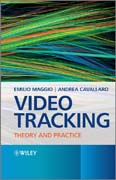
Video Tracking provides a comprehensive treatment of the fundamental aspects of algorithm and application development for the task of estimating, over time, the position of objects of interest seen through cameras. Starting from the general problem definition and a review of existing and emerging video tracking applications, the book discusses popular methods, such as those based on correlation and gradient-descent. Using practical examples, the reader is introduced to the advantages and limitations of deterministic approaches, and is thenguided toward more advanced video tracking solutions, such as those based on the Bayes’ recursive framework and on Random Finite Sets INDICE: Foreword. About the authors. Preface. Acknowledgments. 1 What is video tracking? 1.1 Introduction. 1.2 The design of a video tracker. 1.3 Problem formulation. 1.4 Interactive vs. automated tracking. 1.5 Summary. 2 Applications. 2.1 Introduction. 2.2 Media production and augmented reality. 2.3 Medical applications and biological research. 2.4 Surveillance and business intelligence. 2.5 Robotics and unmanned vehicles. 2.6 Tele-collaboration and interactive gaming. 2.7 Art installations and performances. 2.8 Summary. Reference. 3 Feature extraction. 3.1 Introduction. 3.2 From light to useful information. 3.3Low-level features. 3.4 Mid-level features. 3.5 High-level features. 3.6 Summary. References. 4 Target representation. 4.1 Introduction. 4.2 Shape representation. 4.3 Appearance representation. 4.4 Summary. References 5 Localisation.5.1 Introduction. 5.2 Single-hypothesis methods. 5.3 Multi-hypothesis methods. 5.4 Summary. References. 6 Fusion. 6.1 Introduction. 6.2 Fusion strategies. 6.3 Feature fusion in a Particle Filter. 6.4 Summary. References. 7 Multi-target management. 7.1 Introduction. 7.2 Measurement validation. 7.3 Data association. 7.4 Random Finite Sets for tracking. 7.5 Probabilistic Hypothesis Densityfilter. 7.6 The Particle PHD filter. 7.7 Summary. References. 8 Context modeling. 8.1 Introduction. 8.2 Tracking with context modelling. 8.3 Birth and clutter intensity estimation. 8.4 Summary. References. 9 Performance evaluation. 9.1 Introduction. 9.2 Analytical vs. empirical methods. 9.3 Ground truth. 9.4 Evaluation scores. 9.5 Comparing trackers. 9.6 Evaluation protocols. 9.7 Datasets. 9.8 Summary. References. Epilogue. Further reading. Appendix A: Comparative results. A.1 Single vs. structural histogram. A.1.1 Experimental setup. A.1.2 Discussion. A.2 Localisation algorithms. A.2.1 Experimental setup. A.2.2 Discussion. A.3 Multi-feature fusion. A.3.1 Experimental setup. A.3.2 Reliabilityscores. A.3.3 Adaptive vs. non-adaptive tracker. A.3.4 Computational complexity. A.4 PHD filter. A.4.1 Experimental setup. A.4.2 Discussion. A.4.3 Failure modalities. A.4.4 Computational cost. A.5 Context modelling. A.5.1 Experimental setup. A.5.2 Discussion. References. Notation. Acronyms. Index.
- ISBN: 978-0-470-74964-7
- Editorial: John Wiley & Sons
- Encuadernacion: Cartoné
- Páginas: 288
- Fecha Publicación: 26/11/2010
- Nº Volúmenes: 1
- Idioma: Inglés
